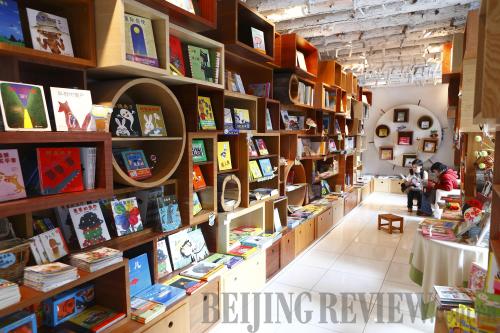|
 |
|
YOUNG READERS' PARADISE: A corner of the famous picture book store, Kid's Republic in Shanghai. The store is owned and operated by the Beijing POPLAR Culture Project Co. Ltd. (CFP) |
"When I grew up, I studied hard out of fear that my parents wouldn't love me any more if I fell behind others," said Nei-Yuh Huang, a professor at the National Taiwan Normal University and writer and translator for children's picture books. "Then one day a picture book magically changed my life for good because it taught me, via a little story, that learning should be a way to empower yourself for loving others in a better way. That picture book informed me that love, instead of fear, should be the inner motivation for learning."
Picture books first appeared in the 18th century in Europe, and reached the golden age in the United States in the 1930s. After becoming popular in South Korea and Japan in the 1950s and the 1960s, parents in Taiwan began to read picture books to their children in the 1970s.
"Picture books, in a modern sense, are a new thing for the Chinese," said Du Naifang, consultant for the Giving Tree Children's Picture Books Publishing House (the Giving Tree) and former editor in chief of Parenting Science, a monthly magazine on children's education.
However, an increasing number of picture books for children are now available on the Chinese mainland. While foreign titles still dominate, homegrown authors are catching up.
Picture books emphasize the connection between pictures and texts. Pictures are not only a tool for illustration but also an important part of storytelling. Some books even tell the story without a single word.
Topics of picture books can cover all aspects of a child's life, including friendship, family love, dignity of life and the natural environment. Good picture books are more like an art work that can be collected and handed down in the family for generations, said Huang.
"Compared with other popular types of children's books on the mainland, they are quite different in content, form and the painting skills," said Du. "Lianhuanhua, or picture storybooks, a traditional choice for Chinese children, are often based on Chinese literature classics, such as The Romance of the Three Kingdoms, while picture books are often inspired by daily life incidences, thoughts and emotions."
People assume writing and painting for children are a piece of cake for artists, but actually drawing pictures and writing stories for them are a demanding job.
"Words must be chosen very carefully to be concise, funny and in accordance with children's reading habits, since there should be few words," said Du. "What's more, artists have to pay attention to every detail of the picture, the painting technique and style of the pictures, making sure those pictures are easily understood by all, especially kids because pictures are the main source for them to comprehend the story."
Picture books, a genre of children's literature, are widely recognized as the most suitable reading materials for preschool education.
Cao Wenxuan, a writer and expert in children's literature, pointed out one problem with children's reading materials on the mainland. "Children's books can be divided into two types: One for kids before their characters are shaped and one after that. But Chinese parents often take books of the second kind for their kids under school age," Cao said.
Cao said it's a serious problem that "many Chinese children have missed the phase of reading picture books, which are designed to help shape their personalities as a combination of true beauty, wisdom and kindness, while in developed countries such as the United States and Japan, each child from the middle class would read hundreds of picture books before growing up."
The most important function of picture books is not moral teaching but helping children know about the world through equal communication and dialogue, said Du.
"It can help children learn about social etiquette, sharing with others, the art of compromising and how to deal with negative emotions," she said.
While helping kids to learn a language, manage emotions and cultivate reading habits, reading picture books can help families function properly, said Huang.
"As there are more and more special families, such as single-parent families, step-parent families, and families that have adopted children, reading picture books together with their kids will help parents to maintain a healthier atmosphere and relationship in the family with love to hold everything together," she said.
"Picture books are intuitive, vivid and designed to arouse the curiosity for reading in children," said Xu Lu, Deputy Manager of Hubei Dolphin Media Co. Ltd., China's top brand for children's books. "With cute stories, hidden emotions and life philosophy, they can exercise an invisible influence on children's reading and thinking habits and language competency."
| 